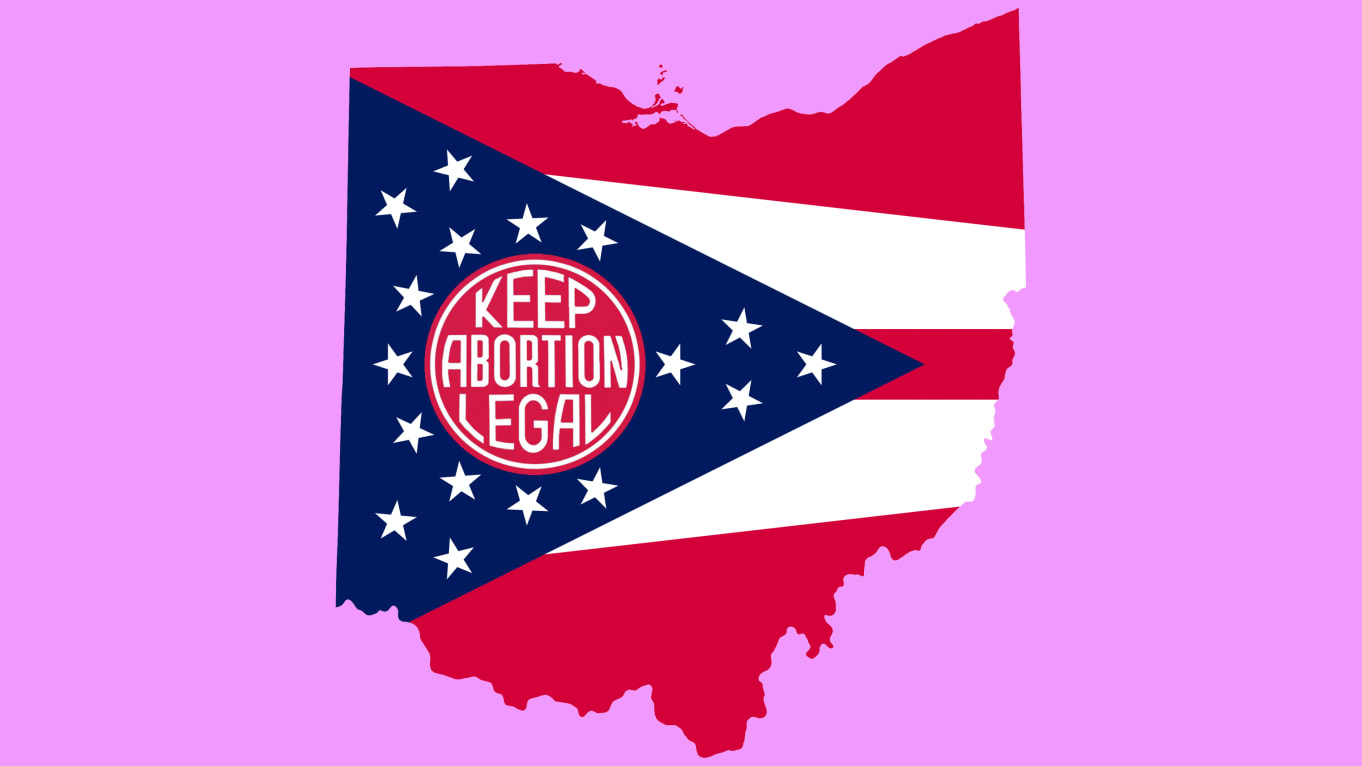“The GOP, like an untrained mutt, cannot stop ro
Post# of 128841
Ohio’s Failed Ballot Measure Shows GOP Is Going ‘Streisand Effect’ on Abortion Access
STEPPING ON ALL THE RAKES
Republicans know abortion is popular, so they tried to make it harder for voters to legalize it. Now they’re losing on reproductive rights—in state after state.
Erin Gloria Ryan
Published Aug. 09, 2023 9:33AM EDT
https://www.thedailybeast.com/ohios-failed-ba...ref=scroll

OPINIONA photo illustration of the map of Ohio and Ohio state flag with a Keep Abortion Legal sign superimposed.
On Tuesday, Ohio voters overwhelmingly rejected Issue 1, a ballot measure designed to take power away from voters. It’s just the latest in a series of examples of how the Republican Party’s hostility toward abortion rights may be unwittingly motivating even moderate and center-right voters to support abortion access.
It’s the Streisand Effect, brought to us by Samuel Alito.
Issue 1 would have raised the threshold of victory for public referendums in the Buckeye State from 50 percent plus one vote to 60 percent, and make it more difficult for citizens to get a referendum on the ballot in the first place.
Most people paying attention could have called this from the Detroit side of Lake Erie. Early voting and mail-in voting numbers helped shatter records for an off-year, off-month election.
Issue 1 failed for the same reason that a measure offering voters the opportunity to add extra potholes all the roads might fail. It was, essentially, a proposal to further empower a gerrymandered far-right legislature in a state that consists primarily of people who fancy themselves moderates, at the expense of the state’s citizens, who are already disempowered due to Ohio’s cartoonishly anti-democratic gerrymandering.
Among Issue 1’s many issues was what it aimed to block—and sloppy attempts by the far-right to lie about Issue 1’s purpose and intent. Ohio’s far-right is so used to getting its way—and is so disconnected from the actual views of Ohioans—that it seems like they actually believed they’d get away with pissing on their constituents’ legs and telling them that it’s raining.
“The GOP, like an untrained mutt, cannot stop rolling in the stench of the dead squirrel that is their extreme position on abortion access. They are at the bottom of a hole, and their best pitch is to keep digging.”
Tuesday’s special election wasn’t even supposed to happen. Back in January, Republican legislatures canceled the August special election. But they changed their tune in May, when it was clear that supporters of abortion were gathering signatures in order to get an initiative on the ballot that would have put Ohio abortion rights up to a public vote in November.
Then, suddenly, mysteriously, the legislature had a change of heart. The August special election was added back into the calendar, and the only issue being considered would be Issue 1.
Polling shows that just shy of 60 percent of Ohio voters support abortion access in the state. Nevertheless, after the Supreme Court struck down Roe v. Wade, the state’s far-right government got busy passing and enacting a six-week abortion ban, apocryphally known as a “Heartbeat Law.” The ban is currently caught up in legal challenges, so as of now, abortion is legal in Ohio up to the point of fetal viability, around 22 weeks—technically.
But what’s legal on paper and what’s available in practice aren’t exactly on speaking terms. Infamously, a ten-year-old rape victim caught up in the ban’s legal back-and-forth was forced to travel across state lines to Indiana to receive an abortion. Ohio’s zealot attorney general, Dave Yost, after doubting the existence of the girl’s case in the first place, used that as an opportunity to get into a public slapfight with the doctor who provided the girl’s care.
Supporters of Issue 1 did their damndest to gaslight Ohio voters into believing that Tuesday’s special election was about anything but abortion. (It’s about freedom! It’s about keeping special interest groups out of Ohio!)
But that’s a hard sell when anti-abortion zealots have been openly in support of Issue 1, and have stated publicly that it’s purpose is to curtail abortion access. To that point, the Cleveland Plain Dealer quotes Mike Gonidakis, the president of Ohio Right to Life, during its coverage of the vote. (Just as the far-right is overrepresented in a gerrymandered state government, so, too, are men overrepresented in organizations that exist solely to regulate women’s bodies. Call me when you get pregnant, Mike.)
Ohio should be a warning to anti-choice conservatives around the country that a lot of people hate their bad ideas.
Actually, there were several warnings to anti-choice conservatives across the U.S. before Tuesday.
Voters do not support putting government officials between a woman and her gynecologist. People don’t want laws to project an image of a jowly AARP-eligible small-time politician peering judgmentally over the stirrups. We are a divided nation, but a definitive percentage of voters—and an even more definitive percentage of reproductively capable voters—agree that this is fucking creepy.

Marion County Prosecutor Ray Grogan and Ohio Right to Life president Mike Gonidakis meet with people after speaking about Issue 1 at the Marion County Republican Party headquarters in Marion, OH on July 13, 2023.
Conservatives could have learned their lesson from Kentucky. Or Montana. Or Michigan. Or Kansas. Or Wisconsin. In each of these purple-to-red states, abortion was on the ballot after Roe fell, and in each of those states, voters chose to support abortion rights or reject abortion restrictions.
But if there’s one thing the anti-choice movement cannot learn, it’s to take the W.
After the Dobbs decision left laws regulating abortion up to the states—undoing decades of legal precedent and throwing millions of American women back to the 1960s— Supreme Court Justice Samuel Alito smarmed that if Americans wanted abortion rights, they could always vote for them.
At the time, the comment seemed like a gloat from a man confident that resistance to his agenda was futile. But voters responded to Alito’s challenge by accepting it.
Abortion has galvanized voters across the country, in unexpected places, and the passion surrounding it is not waning. New CNN polling out on Tuesday found that 64 percent of Americans do not support the Supreme Court’s ruling to overturn Roe v. Wade—the same percentage who said they disapproved of Dobbs right after Dobbs was officially announced. And 84 percent of voters say that sharing their view on abortion with a candidate is either essential or very important.
The GOP Is the Party of ‘F**k You’
THIS AIN’T LINCOLN
David Rothkopf
https://www.thedailybeast.com/the-gop-is-the-party-of-fk-you
And yet. The GOP, like an untrained mutt, cannot stop rolling in the stench of the dead squirrel that is their extreme position on abortion access. They are at the bottom of a hole, and their best pitch is to keep digging.
There are nine other states, besides Ohio, where citizens can amend the constitution via public referendum. Will the GOP Streisand Effect its way to a post-Roe world—where American women have more access to abortion than they did before Alito flapped his yap? Is the American pro-choice movement Sideshow Bob in a parking lot full of rakes (or coat hangers)?
Time will tell, but voting patterns point to yes. Let’s see what innovative Gaslight The Vote tactics the Ohio GOP has up its sleeve for November.
https://en.wikipedia.org/wiki/Streisand_effect
Why is the Streisand Effect called the Streisand Effect?
The Streisand effect is an unintended consequence of attempts to hide, remove, or censor information, where the effort instead backfires by increasing ...
It is named after American singer and actress Barbra Streisand, whose attempt to suppress the California Coastal Records Project's photograph of her cliff-top residence in Malibu, California, taken to document California coastal erosion, inadvertently drew greater attention to the photograph in 2003.

 (2)
(2) (0)
(0)